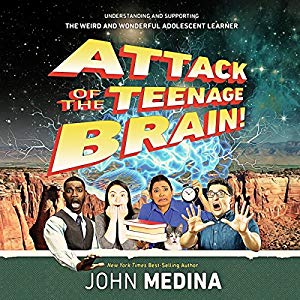As long as I’ve been in this field – heck, as long as I’ve been a teacher – the concept of executive function has floated around as a core way to discuss students’ academic development.
Although the concept has a technical definition – in fact, more than one — it tends to be presented as a list of cognitive moves: “prioritizing, switching, planning, evaluating, focusing, deliberately ignoring…”
I myself have tended to think of executive functions this way: all the cognitive skills that don’t include academic content, but matter in every discipline. So, if I’m trying to execute a lab in science class, I need to …
… focus on this thing, not that thing,
… decide where to begin,
… decide when to switch to the next step,
…realize that I’ve made a mistake,
…evaluate options to fix my mistake,
And so forth.
Crucially, that list applies to almost any academic task: writing an essay, or evaluating the reliability of a historical source, or composing a sentence in Spanish using a new verb tense…
So: these executive functions help students in school – no matter the class that they are in.
To say all this in another ways: EFs resist easy definition but are mightily important in schools and classrooms. (Truthfully they’re important in life, but that broader range lies outside of this blog’s focus.)
Today’s News
I recently saw an enthusiastic response to a newly-published study that explores, reconceptualizes — and debunks? — EFs. Because EFs “are mightily important,” such reconceptualization & debunkage merits our thoughtful attention.
Here’s the story.
A research team led by Andreas Demetriou wanted to see if they could translate that long list (“prioritizing, switching, evaluating,” etc.) into a core set of mental processes.
So: a carbon atom might look different from an iron atom, but both are different ways of putting protons, neutrons, and electrons together. Likewise, “prioritizing” and “switching” might seem like two different processes, but they could instead be different arrangements of the same mental elements.
Demetriou’s team focuses on two core mental processes – their “protons and electrons.” Roughly, those mental processes are:
- Forming and holding a mental model of the goal, and
- Mapping that mental model onto the situation or problem.
For complicated reasons, Team D combines these two processes with a label: the AACog mechanism. They then run a lengthy series of studies using a GREAT variety of different tests (Stroop this, Raven’s that) across a wide range of ages.
When they run all the calculations, sure enough: the AACog mechanism underlies all those other EFs we’ve been taught about over the years.
As they write: “AACog is the common core running through all executive functions.” (That’s an extraordinary claim, no?)
And, development of the AACog mechanisms explains all sorts of increasing mental capacities: symbolic exploration, drawing inferences, using deductive reasoning, and so forth. (The concentric circles representing this argument challenge all of my AACog mechanisms!)
In other words, this model explains an ENORMOUS amount of human cognitive processing by focusing on two elements.
What It All Means
I wrote above that this study received an “enthusiastic response” when it came out.
In my twitter feed at least, it was packaged with basically this message:
“All those people who were nattering on about EF were having you on. Look: we can boil it down to basically one thing. No need to make it so complicated!”
I can understand why Twitter responded this way: the title of the Demetriou et al. study is: “Executive function: Debunking an overprized construct.” No wonder readers think that the idea of EFs has been debunked!
At the same time, I’m not so sure. I have three reasons to hesitate:
First:
Quoth Dan Willingham: “One study is just one study, folks.” Until MANY more people test out this idea is MANY more ways, we shouldn’t suddenly stop thinking one thing (“EFs exist!”) and start thinking another (“EFs are the AACog mechanism in disguise!”).
We need more research — LOTS — before we get all debunky.
Second:
Let’s assume for a moment that the AACog mechanism hypothesis is true. What effect will that have on discussions in schools?
Honestly, I doubt very much.
The “AACog mechanism” is itself so abstract — as are the “modeling” and “mapping” functions that go into it — that I doubt they’ll usefully replace “exective functions” in daily conversations.
Imagine that a learning specialist says to me: “This student has a diagnosed problem with her AACog mechanism.”
I’ll probably respond: “I don’t understand. What does that mean?”
The learning specialist will almost certainly respond: “Well, she has difficulty with prioritizing, task switching, initiating, and so forth.”
We’re back to EF language in seconds.
Third:
I’m not sure I buy the argument that the “AACog mechanism” DEBUNKS “executive function.”
Imagine this logical flow:
- Carbon and iron are made up of the same sub-elements: protons, neutrons, and electrons.
- Therefore, carbon and iron don’t really exist.
- Voila: we’ve debunked the idea of carbon and iron.
Well, that logic just doesn’t hold up. Carbon and iron DO exist, even as meaningfully different arrangements of sub-particles.
So too:
- EFs all boil down to the AACog mechanism, which is itself just “mental modelling” and “mapping of models onto reality.”
- Therefore, EFs don’t really exist.
- Misson Debunk Accomplished!
I just don’t track that logic.
We understand human cognitive complexity better, but the complexity hasn’t gone away. (We understand carbon and iron better now that we know about protons and neutrons, but the periodic table is still complicated.)
This model helps us think differently about mental functions across academic disciplines. Those new thought patterns might indeed be helpful — especially to people who create conceptual diagrams of cognition.
But I don’t think it will radically change the way teachers think and talk about our students.
TL;DR
A group of thoughtful scholars have put together a new model of cognition explaining executive functions (and a whole lot more).
What does this mean for us?
- In ten or fifteen years, EF experts might be talking to us differently about understanding and promoting these cognitive moves.
- In the meantime, don’t let oversimplications on the interwebs distract you. Yes: “executive function” is a mushy and complicated category — and yes, people do go too far with this label. But something like EFs exist, and we do need to understand their complexity.
Demetriou, A., Kazali, E., Spanoudis, G., Makris, N., & Kazi, S. (2024). Executive function: Debunking an overprized construct. Developmental Review, 74, 101168.






